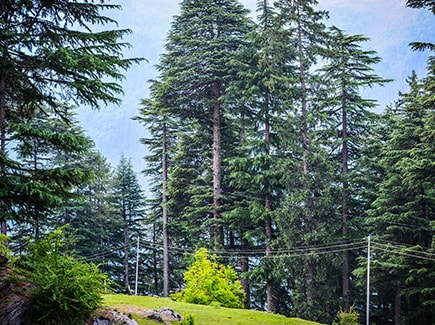Click here to read the original version of the blog in Marathi: https://bit.ly/2CQPngr
I first saw him some twenty-five years ago. Although I had heard and read a lot about him earlier, somehow I hadn’t got an opportunity to see him until then. Of course, one has to visit his territory to catch his glimpse, but even then, sighting him isn’t guaranteed. And that’s exactly what makes spotting this awe-inspiring, swift and alert beast so exciting. What’s rare is indeed precious! Whenever I start talking about him, I simply get mesmerized, so much so, that I even miss out on mentioning whom am I referring to! Some of you must have guessed it by now… I’m speaking about the gem of Indian fauna… The yellow and black striped Tiger – also popularly known as the Bengal Tiger and zoologically Panthera tigris tigris. Even after having seen him several times, over the last twenty-five years, on my numerous safaris across the many jungles and national parks of India, my senses just keep on asking for more of him. A unique blend of power, elegance and discipline, Jim Corbett rightly described him as the ‘Gentleman of Jungle’. This year, with life coming to a standstill owing to the Covid-19 pandemic, I’m badly missing visiting his home and having a rendezvous with him. This blog is just another reason for reliving all my roaring memories.
There’s yet another occasion for this blog. Every year, Global Tiger Day often called International Tiger Day is celebrated around the world on the 29th of July. In 2010, it was this very day, when thirteen tiger range countries (India, Bhutan, Nepal, Vietnam, Myanmar, Malaysia, Indonesia, China, Russia, Bangladesh, Thailand, Cambodia, and Laos) had come together in Russia for chalking out a plan to double the number of tigers in the world over the next twelve years, i.e. by 2022. This timeline was decided upon considering the fact that the year 2022 marks the Chinese year of the Tiger. India certainly had an important say in this summit, since India is home to the largest number, i.e. 75% (as per the latest census) of the total tigers in the world, which is around 3900 tigers. In fact, this is the reason that makes the national parks and sanctuaries across India so popular among the wildlife enthusiasts, who visit India in large numbers every year, in the pursuit of catching a glimpse of this magnificent big cat.
Did you know, tiger, which is considered to be an indicator of the health of India’s forests, is actually not native to India. Today, even though tiger can be found across the length and breadth of our country – from the Himalayan forests to the deserts of Rajasthan and from the mangrove forests of Sundarbans to the perennially green jungles of Kerala, the tiger is native to the snow region of Siberia. Tigers migrated to the Indian soil, some 11,000 to 12,000 years ago. With dense forests, enough of prey, and ample of water making for a favourable environment for survival, tigers eventually settled down across the various regions of India. Eventually, with tigers gaining religious significance as the vehicle of Goddess Durga, they were protected. However, in the reign of Kings and the British Raj, this majestic animal was hunted on a large scale. Before the onset of the 19th century, some 40,000 tigers resided across the forests of India, however, over the next 40 – 50 years, this number shrunk to a mere 2000. This indeed set off the alarm bells that if these royal and mighty apex predators aren’t saved, they would be only seen in the zoos in the near future. Therefore, in the wake of this realisation, in 1973, the government of Indian initiated Project Tiger under the guidance of the experts in the subject. In its first phase, the project which was rolled out at 9 different national parks in India, has today led to the protection of tigers across 50 jungles in the country. This ranges from Mudumalai in Tamil Nadu to Namdapha in Arunachal Pradesh and from Rajasthan’s Ranthambore to Similipal in Odisha – tigers living across a wide spectrum of ecosystems, in various states of India. The recently declared tiger census is evident in the fact that the endangered tigers are indeed being conserved in India. The census was taken across various protected zones around India by installing camera traps. As per the statistics of the 2018-19 census, it was declared that the number of tigers in India is 2967, a promising rise from the earlier count of 1706, taken in 2010.
In spite of the good news that the number of tigers in India is on the rise, having a glimpse of him is in no way a cakewalk. At the end of the day, he’s the wild free spirit of the jungle and definitely won’t show up whenever we want him to. Therefore, if we aspire to sight tigers in the wild, first we need to understand them. Although a predator, belonging to the cat family, tigers don’t live in groups. It’s only for a mating that the male and female come together. However, once the female senses that she’s about to get pregnant, she pushes the male away and distances herself from him. After giving birth to the cubs, she turns extremely vigilant and aggressive for the next two years. Moreover, with the cubs being notorious, she always needs to follow them and stay cautious and vigilant of any potential danger. This means, that in a jungle where there’s a tigress with her cubs, there’s always a better chance to spot this big cat. On the other hand, things work differently for male tigers. They have their own territories. Each male occupies an area of around 10 to 20 sq. kms. A tiger watches out for any trespasser (another male tiger) who could have walked into his territory. He does so by going around his territory once a day, either in the morning or in the evening. Females are however exempted from any restrictions on entering the male territories. Moreover, at the peak of summer, when the Mercury hits a sweltering 40 to 42 degrees Celsius, it’s more common to spot a tiger by a spring or soaking itself in a pond. Knowing these things definitely increases our probability of spotting a tiger in the jungle.
[gallery type="slideshow" ids="45790,45789,45791"]
Over the last 25 years, I have been travelling and exploring the jungles on my numerous wildlife safaris across some of the top national parks in India…From Tadoba to Kanha; from Bandhavgarh to Pench; from Satpuda to Ranthambore; from Jim Corbett to Sundarbans, Kaziranga, and more… Here, I’ll like to share one anecdote with you before I sign off.
It was a hot and bright May afternoon and we were taking our last round of the park on that jungle safari. In the scorching heat, our gypsy reached the Khitauli Gate of the Bandhavgarh National Park in Madhya Pradesh. Like always, while entering, Salim, our driver, learnt about the movement in the morning from the forester at the gate. There’s a fixed waterhole at which the male tiger of Khitauli comes to drink water every evening without fail… So we were assured of the sighting and also of a great opportunity to click some amazing pictures. However, sighting a tiger is in fact a ‘game of patience’. What assures a greater possibility of spotting the big cat is not minding waiting at a place at least for an hour. It so happens that in the beginning, everyone’s in high spirits and enthusiastically starts deciphering the various sounds of the jungle. Their eyes, ears, and almost all the senses try really hard to locate the tiger around. However, after a while, all this enthusiasm begins to recede.
The heatwave was gradually subsiding. It was past 5:30 now. The male of Khitauli was nowhere to be seen. Tigers are generally quite punctual. It seemed as if something was wrong that day. When we were just about to lose hope, suddenly we could hear the alarm call of the monkeys from the nearby hill, and we all were alerted at once. Since the monkeys were screeching, it was evident that the tiger was on his way. Now everyone was trying to guess, from where exactly will he come towards the waterhole. At that very moment, we heard someone crying out in a low voice from one of the gypsies, which meant someone had definitely caught his glimpse. Our gypsy was parked at the far end, from where we weren’t able to see him at all. We almost thought, Salim had parked our gypsy at the wrong spot, just until we realised we were wrong. And what happened then, was straight out of a fantasy. Down the hill, he walked directly in front of our gypsy and starting guzzling from the waterhole. It was evident that he was quite thirsty owing to the sweltering heat. He then walked into the waterhole and soaked himself in the water to beat the hot summer day. Believe me, it almost felt like he was putting up a show in front of us… And it was indeed such a spectacular one. The gypsy in front of him and the humans in it, their movements, voices… seemed to be affecting him the least. We were that trivial for him. And when he locked eyes with us, the moment was just enough to intimidate and give us goosebumps. Just after a while, very dramatically, the tiger came out of the waterhole, turned around just to look at us once, and very regally walked back into the jungle.
It has been 5 years now, and I still remember this incident as if I’m witnessing it at this very moment. The yellow and black stripes indeed cast a spell on us and every time I’m left equally spellbound. That’s why I always say, the world is made up of just two kinds of people – those who have seen a tiger and those who haven’t.
[gallery type="slideshow" ids="45792,45793,45794,45795"]
Written by: Makarand Joshi
Makarand has been a part of the Travel and Tourism industry for the last 25 years. He has been a Naturalist, & Journalist. He pens down his thoughts and stories on destinations, environment, and more, that will leave you spellbound. Nature is what he admires and literature is what he lives for.























































Post your Comment
Please let us know your thoughts on this story by leaving a comment.